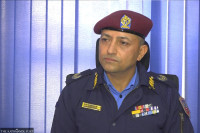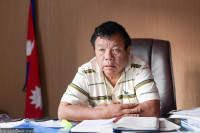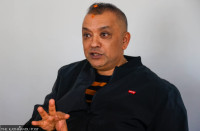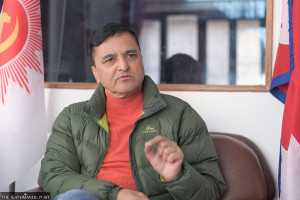Interviews
We have created ample space for a third wave: Dr Sher Bahadur Pun
If a Covid-19 third wave hits the country, children will be the most at risk because they are not vaccinated.
Anup Ojha & Drishna Sthapit
When the country was in the throes of the first and second waves of the Covid-19 pandemic, Dr Sher Bahadur Pun, chief of the Clinical Research Unit at Sukraraj Tropical and Infectious Disease Hospital in Teku, spent most of his time at the hospital observing the patients, taking notes and treating them. As a front liner, Pun had first-hand experience of the coronavirus disease and the many ways it manifested in patients. He was one of the leading voices who called out the government for its failure to contain the virus spread, increase the test numbers and shore up the country’s floundering health care system. As the spectre of a third wave of infection looms large, Anup Ojha and Drishna Sthapit of the Post caught up with Pun and inquired him about the current Covid-19 situation.
The interview has been condensed for clarity.
How do you look at the present Covid-19 scenario in Nepal?
We are still at risk. The current infection status is just like the situation we experienced between the first and second waves. What is worse is that this time, the prohibitory orders have been eased across the country even when the daily infection numbers are over 2,000 mark. In recent weeks, many people seem to have developed this false sense of security, that things have become normal because everything has reopened. But that is absolutely not the case. Covid-19 cases are rising again. I personally feel that relaxing the restrictions has increased the risk of virus transmission. Already, we are seeing the number of cases going up.
Compared to last week, the infection rate has doubled in the country. On July 18, the daily number of cases was at 1,223 and a week later on July 27, the number shot up to 2,726. What do you make of this?
This clearly indicates that people are participating in social gatherings, political rallies and meetings, fuelling the virus spread. Health protocols are not being followed and the authorities are not enforcing them. People are out and about as though things have gone back to normal. The fact that the cases have doubled shows that things are not normal. Because of our complacency, I’m afraid we will face a third wave.
There are talks about a third wave hitting the country. Does that mean that we have already come out of the second wave?
If we analyse the data between the first and second waves, the average daily infection rate was 70 to 100. But now, with the prohibitory orders relaxed, the daily cases have risen to 2,000 or above. Positive cases below five percent is considered a normal situation but in our case, the infection rate is still around 20 percent. This data is the same when the prohibitory orders were eased in the first week of June. So if we compare and analyse the data, we are still in the second wave.
Are we prepared for a third wave?
We are not fully prepared. There are possibilities of new variants of concern gripping us anytime, which could lead to a third wave. If you compare the recent data on daily cases, the infection rate is still going up. But we don’t see people following basic health protocols—and this has set the ground for a third wave.
Those who were not infected in the second wave or those who were infected in the first wave (six or seven months ago) could catch the infection during the third wave. And if any of the virus variants that are of concern were to spread, everyone will be at risk. So it’s very important to monitor the present situation and tread cautiously.
The vaccination drive has started to pick up but there are issues when it comes to its administration. Crowds at vaccination centres could lead to the spread of the virus. What are your thoughts about this?
This has been my concern all along. I still remember at the beginning of the second wave, the inoculation drive with the Vero Cell vaccine had just started, and many people visited me saying they got infected after 8 to 10 days of taking their jabs. It’s because the vaccination centres were overcrowded. The crowd situation at vaccination centres has still not improved. If we continue this way, the vaccination centres themselves can spread the virus. The Nepal government has done a commendable job regarding vaccination, but if we fall behind in crowd management at vaccination centres, it could be costly.
The government has routinely extended prohibitory orders but has done little to enforce them. What risk do you see here?
Since almost everything has reopened, people are acting as if normalcy has returned. This is one of the reasons Covid-19 cases are surging of late. It’s obvious that we cannot impose lockdown forever, but we should be using the prohibitory order period to plug the loopholes in infection control. How successful have we become in terms of management? There is a question. We have passed through the same kind of situation before, and if we do not learn from our past experiences, the same problems are bound to repeat.
If we look at social media now, we see people posting pictures of social gatherings and other group activities. Such events provide ample opportunity for virus transmission. Before the second wave, too, people had engaged in the same kind of activities.
There are concerns about children getting affected by the third wave. Is there any scientific basis to this claim?
Children are at risk because they are not vaccinated. And until now, we do not have reliable data on the effectiveness of vaccines on children. Until we have safe and effective vaccines for children, they should not be vaccinated. Covid-19 vaccines for children are in the research phase. If a new wave hits, all unvaccinated people will be at risk—not just children.
What challenges do you anticipate in case of a third wave?
In the first wave, there was a shortage of hospital beds. In the second wave, there were shortages of oxygen and hospital beds. Many people died during the second wave due to a shortage of oxygen. Many hospitals refused to admit patients citing oxygen shortage.
In the event of a third wave, the challenges, I think, will be related to children because there are fewer children’s hospitals and a limited number of paediatricians in Nepal. Serious cases will need intensive care, but we don’t have enough intensive care beds for children. The intensive care units for adults do not work for children because specialised doctors and special equipment are needed for treating children.
So to prepare for a possible third wave, what we can do is train health officials on paediatric treatment and care. If this happens, the risk can be reduced to some extent. We should learn from other countries where doctors from various fields are working together to fight Covid-19. Just allocating hospital beds for children will not be sufficient. We need to prepare health workers to treat infected children.




 8.12°C Kathmandu
8.12°C Kathmandu.jpg)













